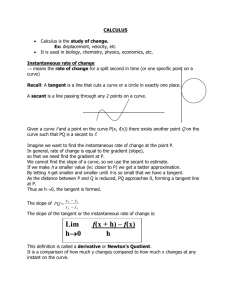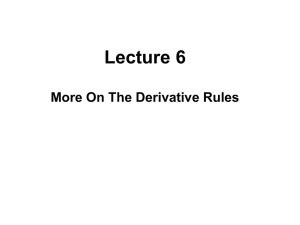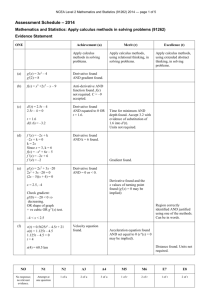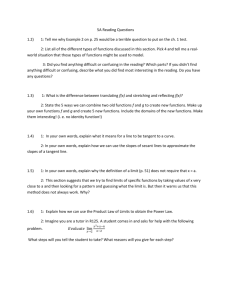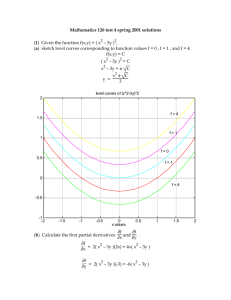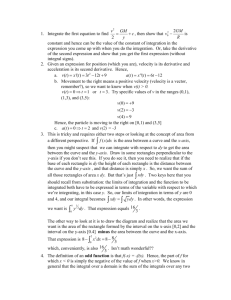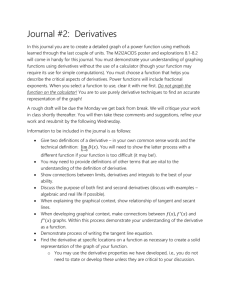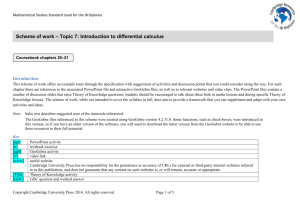IB Math Studies Calculus Revision Notes: Differentiation & Applications
advertisement
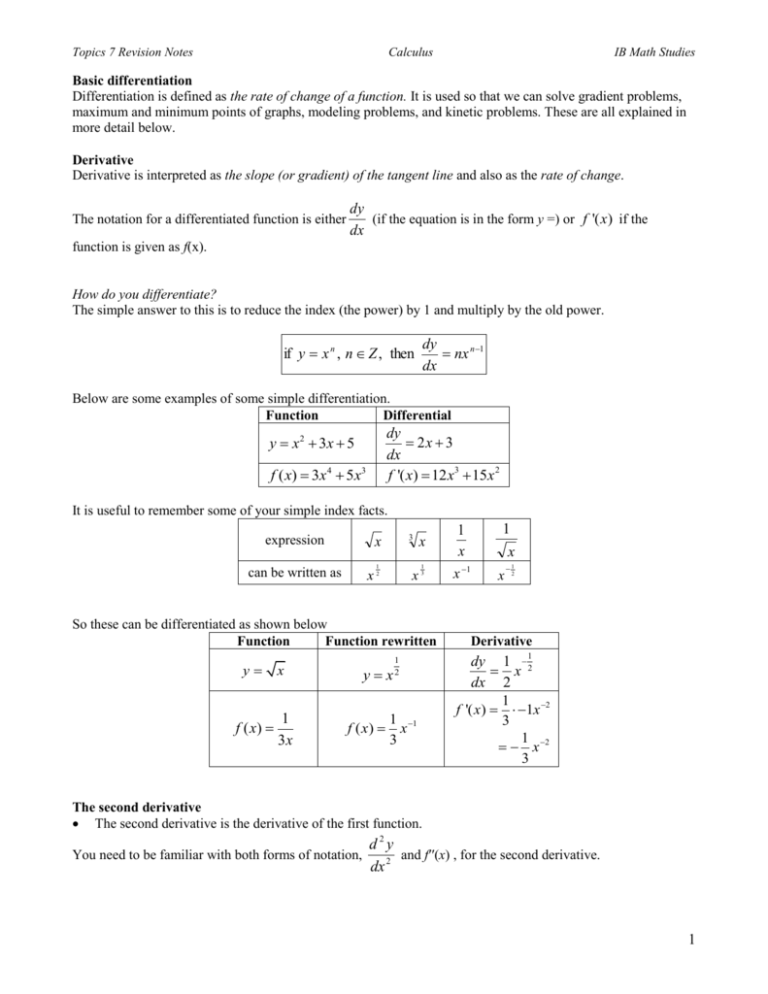
Topics 7 Revision Notes Calculus IB Math Studies Basic differentiation Differentiation is defined as the rate of change of a function. It is used so that we can solve gradient problems, maximum and minimum points of graphs, modeling problems, and kinetic problems. These are all explained in more detail below. Derivative Derivative is interpreted as the slope (or gradient) of the tangent line and also as the rate of change. The notation for a differentiated function is either dy (if the equation is in the form y =) or f '( x) if the dx function is given as f(x). How do you differentiate? The simple answer to this is to reduce the index (the power) by 1 and multiply by the old power. dy nx n 1 dx if y x n , n Z , then Below are some examples of some simple differentiation. Function Differential dy 2x 3 dx f '( x) 12 x3 15 x 2 y x 2 3x 5 f ( x) 3 x 4 5 x 3 It is useful to remember some of your simple index facts. expression can be written as 3 x x 1 2 x x 1 3 So these can be differentiated as shown below Function Function rewritten y f ( x) x 1 3x yx f ( x) 1 2 1 1 x 3 1 x x 1 1 x x 12 Derivative dy 1 12 x dx 2 1 f '( x) 1x 2 3 1 x 2 3 The second derivative The second derivative is the derivative of the first function. d2y You need to be familiar with both forms of notation, and f′′(x) , for the second derivative. dx 2 1 Topics 7 Revision Notes Calculus IB Math Studies Applications 1. The gradient function (a.k.a. the slope function) The first application of differentiation is to find the gradient function. The derivative (when it’s not at a specific point) is known as the slope function. 2. Maximum and minimum points Curves can have maximum and minimum points, as shown in the diagram below. Notice that to the left of the maximum the curve is increasing and to the right of the maximum the curve is decreasing. The opposite is true for the minimum point. Increasing and Decreasing To find intervals where a function is increasing or decreasing you need to know: If f ’(x) > 0, for all x in an interval, then the function is increasing on that interval. If f ’(x) < 0, for all x in an interval, then the function is decreasing on that interval. If f ’(x) = 0, then the function is stationary at that point. Maximum, Minimum and point of inflection dy 0 , is called a stationary point. dx A point on a curve at which the gradient is zero, where At a stationary point, the tangent to the curve is horizontal and the curve is ‘flat.’ To find a maximum or minimum: 1. Find the derivative f '( x) . 2. Set f '( x) = 0 3. Solve. 4. To further determine if it’s a maximum or if it’s a minimum: Do a sign diagram (a number line) Choose a number on either side of your value Plug those numbers into the derivative f '( x) check to see if it’s positive or negative. 5. Remember that it is a maximum if your sign diagram changes from positive to negative. It is a minimum if the sign diagram changes from negative to positive. 2 Topics 7 Revision Notes Calculus IB Math Studies 3. Equations of tangents A tangent is a line that touches the outside of a curve at a given point. It will always be a straight line in the form y = mx + c. We can find equations of tangents by first finding the gradient (m) from the differentiated function and then finding the coordinate at the point where the tangent meets the curve and substituting back into the y = mx + c equation. An example of this is shown below in the guided example. Guided example The function f(x) = x3 + 3x2 – 10x (a) Find the gradient when x = 2. (b) Find the x-value of both the maximum and minimum points and distinguish between them. (c) Find the equation of the tangent to the curve at the point where x = 2 Answer (a) Find the derivative function and substitute the value of x given in the question as shown below. f '(x) = 3x2 + 6x – 10 f '(2) = 3(2)2 + 12 – 10 = 14. Answer (b) It’ll be helpful to graph the function on your GDC to get some idea of where the maximum and minimum points are. Now set f '( x) = 0. 3x2 + 6x – 10 = 0 Since this equation doesn’t factor you can use the quadratic formula to solve it: b b2 4ac 6 62 4(3)(10) 6 36 120 6 156 1.08 and –3.08 x 6 6 2a 2(3) To distinguish between them we could do a sign diagram although we can clearly see from the graph that 1.08 is the minimum and 3.08 is the maximum. On the IB Exam draw a rough sketch of the curve to be used as evidence of you using the graph to get to your final answer. Answer (c) From part (a) we already have the gradient of the tangent at x = 2 is 14 y = 14x + b y = 12(2) + b I need to find f(2) so I can finish this… f(x) = x3 + 3x2 – 10x f(0) = 03 + 3(0)2 – 10(0) = 0 0 = 12(2) + b 0 = 24 + b -24 = b The equation of the tangent is: y = 14x – 28. 3 Topics 7 Revision Notes Calculus IB Math Studies OPTIMIZATION EXAMPLE A chemical burns in the air producing energy, g. An equation to show the amount of energy produced after t seconds of being exposed to the air is g (t ) 120t 18t 2 . a) Find the derivative function g '(t ) . b) Find g '(2) . c) Find (i) the time at which the maximum amount of energy is being produced. (ii) the amount of energy being produced at this time. ANSWER 4

